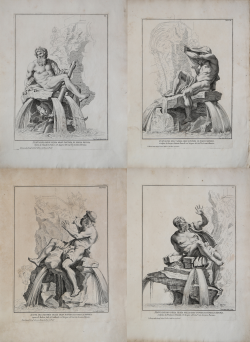







| Reference: | S35249 |
| Author | Francesco Faraone AQUILA |
| Year: | 1704 |
| Measures: | 254 x 362 mm |






| Reference: | S35249 |
| Author | Francesco Faraone AQUILA |
| Year: | 1704 |
| Measures: | 254 x 362 mm |
Etching and engraving, 1704, lettered lower right “Fran Aquila delin. et Sculp” (3 of 4) and one “Fran Aquila del. Et Sculp.”.
Good examples, printed on contemporary laid paper, in good condition.
The four plate show the four river gods of the famous Fountain of the Four Rivers designed in 1651 by Gian Lorenzo Bernini for Pope Innocent X.
Collectively, they represent four major rivers of the four continents through which papal authority had spread: the Nile representing Africa, the Danube representing Europe, the Ganges representing Asia, and the Río de la Plata representing the Americas.
The plates belong to the series Raccolta di Statue antiche e moderne data in luce sotto i gloriosi auspicj della Santita di N. S. Papa Clemente 11. da Domenico de Rossi illustrata colle sposizioni a ciascheduna immagine di Pauolo Alessandro Maffei [...], published by Domenico de Rossi, Rome 1704.
Each one with the caption along bottom and numbered at upper right, lower left: “In Roma nella Stamp.a di Dom.com de Rossi alla pace, con Privil.o”.
Francesco Faraone AQUILA (Palermo 1676 circa – Roma 1740 circa)
|
Francesco Faraone Aquila (or dell'Aquila) (Palermo, 1676 – Rome, 1740) was an Italian engraver who followed in the footsteps of his brother Pietro. Other sources suggest that Francesco was not Pietro Aquila's brother but rather his nephew, and chronological data may indeed confirm this second hypothesis, given that Pietro was of the previous generation and died in 1692. Little is known about his life. We know that in 1690 he moved to Rome, where his brother had already been known for decades for his work as an engraver for the capital's major engraving workshops. Pietro, who was a priest, opened the doors of Roman ecclesiastical patronage for him. Pope Clement XI commissioned him to carry out what would become his greatest achievement: the engraving of the bas-reliefs of the Column of Antoninus Pius and its pedestal. This work remains invaluable today, as the reliefs are subject to deterioration due to atmospheric agents and the loss of the column in a fire in 1759, of which only the base remains, preserved in the Vatican Museums. In 1713, Domenico de Rossi published Raccolta di vasi diversi formati da illvstri artefici antichi e di varie targhe soprapposte alle Fabbriche più insigni di Roma..". The plates of which were designed and engraved by Pharaoh Aquila. Another very important work by Francesco Aquila was the engraving of Correggio's fresco in the dome of Parma Cathedral and that of Raphael's Vatican apartments. But Gori Gandellini, in his book Notizie storici degli intagliatori (Historical News of the Engravers), leaves us a long list of engravings of paintings and frescoes, both Renaissance and Baroque, by Aquila, including those by Carlo Maratta, Francesco Albani, Lanfranco, Ciro Ferri, Pietro da Cortona, Pier Leone Ghezzi, and countless others. Following the antiquarian taste that was gaining traction during the eighteenth century, Francesco Aquila engraved various works from the Roman classical era: statues, vases, triumphal arches, thus meeting the demand, especially from foreign visitors, mostly German and English. His portraits of his contemporaries, both painters and clergy, were also very famous.
|
Francesco Faraone AQUILA (Palermo 1676 circa – Roma 1740 circa)
|
Francesco Faraone Aquila (or dell'Aquila) (Palermo, 1676 – Rome, 1740) was an Italian engraver who followed in the footsteps of his brother Pietro. Other sources suggest that Francesco was not Pietro Aquila's brother but rather his nephew, and chronological data may indeed confirm this second hypothesis, given that Pietro was of the previous generation and died in 1692. Little is known about his life. We know that in 1690 he moved to Rome, where his brother had already been known for decades for his work as an engraver for the capital's major engraving workshops. Pietro, who was a priest, opened the doors of Roman ecclesiastical patronage for him. Pope Clement XI commissioned him to carry out what would become his greatest achievement: the engraving of the bas-reliefs of the Column of Antoninus Pius and its pedestal. This work remains invaluable today, as the reliefs are subject to deterioration due to atmospheric agents and the loss of the column in a fire in 1759, of which only the base remains, preserved in the Vatican Museums. In 1713, Domenico de Rossi published Raccolta di vasi diversi formati da illvstri artefici antichi e di varie targhe soprapposte alle Fabbriche più insigni di Roma..". The plates of which were designed and engraved by Pharaoh Aquila. Another very important work by Francesco Aquila was the engraving of Correggio's fresco in the dome of Parma Cathedral and that of Raphael's Vatican apartments. But Gori Gandellini, in his book Notizie storici degli intagliatori (Historical News of the Engravers), leaves us a long list of engravings of paintings and frescoes, both Renaissance and Baroque, by Aquila, including those by Carlo Maratta, Francesco Albani, Lanfranco, Ciro Ferri, Pietro da Cortona, Pier Leone Ghezzi, and countless others. Following the antiquarian taste that was gaining traction during the eighteenth century, Francesco Aquila engraved various works from the Roman classical era: statues, vases, triumphal arches, thus meeting the demand, especially from foreign visitors, mostly German and English. His portraits of his contemporaries, both painters and clergy, were also very famous.
|